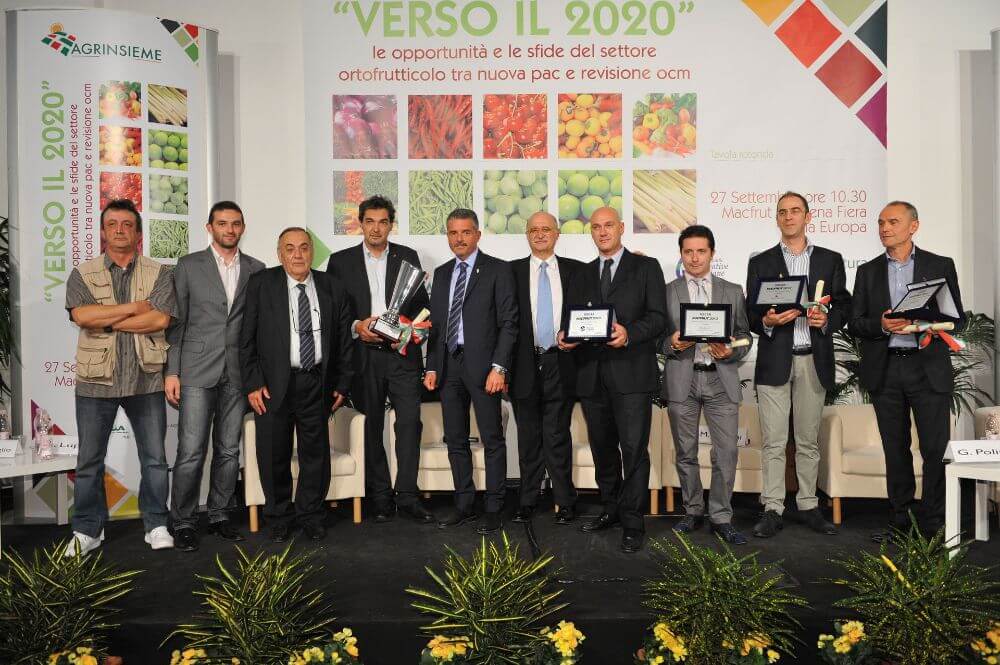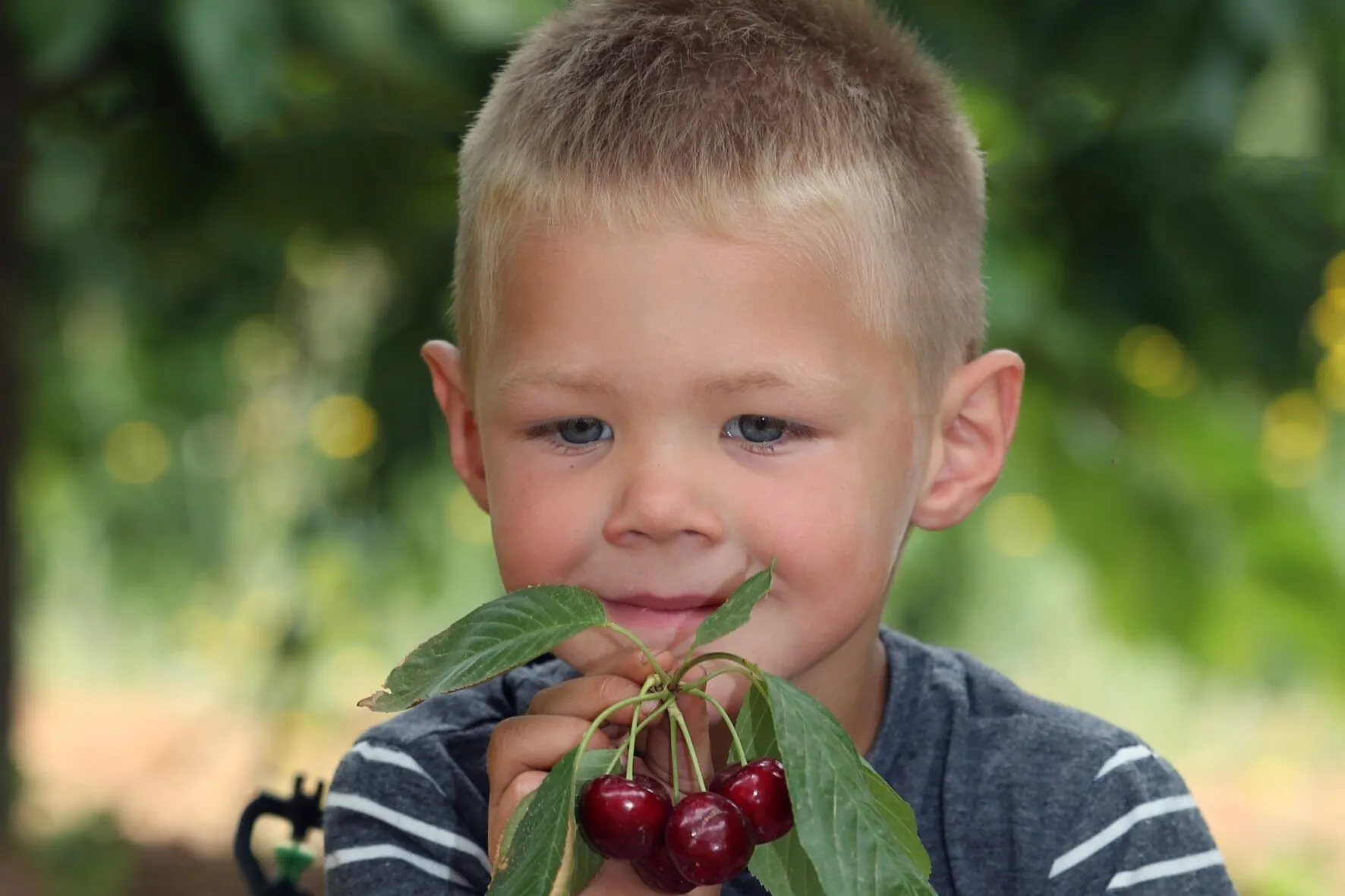The main market for Chilean cherries is in Asia, where during the 2023-2024 season China received 91% of the production, equivalent to 377,033 tons.
The trend in sales price was similar to that of previous seasons, with a high price in early October (over 40 USD/kg - about 38 EUR/kg) and a rapid drop during the same month until mid-December (about 20 USD/kg - about 19 EUR/kg), then stabilizing in the period before and after the Chinese New Year at prices around 10 USD/kg (about 9.5 EUR/kg) (iQonsulting, 2024).
The sales price is determined by various factors, such as the week of market entry, the variety, the size, the color, among others. Regarding the variety, early-harvest cherries can enter the market earlier and achieve better prices. In the case of size, there is a growing valuation from smaller sizes to larger fruit. Likewise, in general terms, the market values darker fruit more and penalizes lighter fruit.
Strategies to improve cherry quality
Fruit size is one of the most important quality parameters when determining price and yield for the producer. To maintain leadership in the sector, it is important to seek alternatives that improve the quality attributes required in target markets.
In this regard, producers have several management strategies to increase the final fruit size, including fruit load regulation (with early thinning of buds and/or flowers being more effective), proper irrigation management, fertilization, and supplementary application of biostimulants and growth regulators during fruit growth.
To better understand the functioning and positioning of the different strategies that the market offers to promote an increase in size, it is necessary to understand the fruit growth curve. Cherries, like other stone fruits, have a double sigmoid growth curve that can be divided into three phases.
Fruit growth phases
The first phase is characterized by an active cell division process of the mesocarp (fruit flesh), which largely determines the potential size at harvest. Phase II is characterized by slower growth of the mesocarp, with pit lignification (hardening) being more relevant, while in phase III, mesocarp cells elongate, stimulated by water intake, making proper irrigation management in this final growth phase more significant.
Depending on the stage of development of the fruit, windows of opportunity for the application of various products open up. Due to the dynamics of phytohormones in the growth and development process of the fruit, several commercial alternatives have been positioned during this period with the aim of increasing size.
Use of biostimulants
Biostimulants are products of organic or inorganic origin, characterized as being environmentally friendly and can be classified into: seaweed extracts, humic acids, fulvic acids, amino acids, glycine betaine, chitosan, silicates, fungal-based biostimulants, and bacterial-based biostimulants. In general, and depending on their origin, they can perform various functions, such as improving tolerance to abiotic stress, enhancing vegetative growth, increasing yields, and improving fruit quality parameters (Afonso et al., 2022).
Among the quality parameters, effects of various biostimulants on size have been identified, proving to be an effective and complementary strategy to growth regulators.
In relation to the biostimulant alternatives validated by CER, the use of Ascophyllum nodosum and Ecklonia maxima stands out, as they have been shown to significantly increase fruit size with applications every 7-10 days from fruit set until harvest, compared to a control without application, with these types of applications generally being complementary to phytohormone applications.
Effects of growth regulators
Among growth regulators, there are several products based on synthetic or natural phytohormones, with effects similar to auxins, cytokinins, and/or gibberellins. Studies carried out during the 2019-2020 season on Skeena and Regina varieties demonstrated the effect of some alternatives, such as the application of 20% NAA (auxins) in full bloom, which resulted in an average of 15.6% more fruit in the category greater than 30 mm in diameter compared to the untreated control.
Similarly, cytokinin-like alternatives were evaluated, with applications in full bloom and fruit set to promote cell division. Results showed that applications of 6-benzyladenine and thidiazuron at 5% significantly increased the final fruit size, shifting the size curve towards larger calibers compared to the untreated control.
Use of gibberellic acid
Another widely used growth regulator is gibberellic acid, whose objective is to increase size by promoting cell elongation. Applications are generally made when the fruit is bright green, with a direct impact on final fruit size.
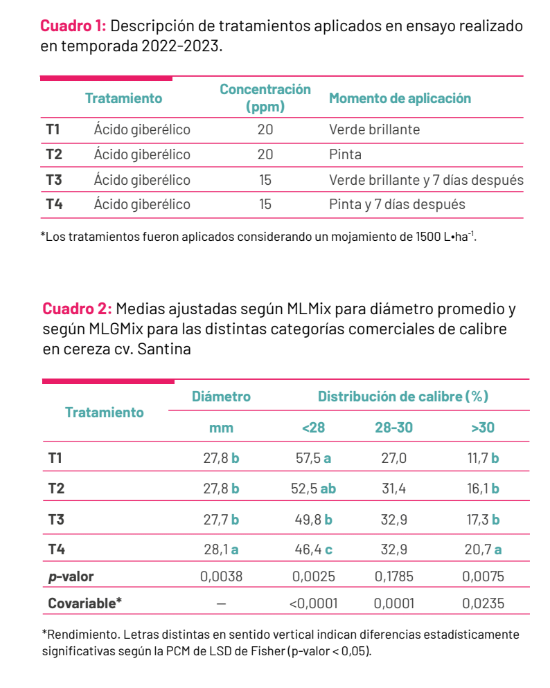
However, several studies have reported that the use of gibberellins causes a delay in color development (Li et al. 2019), which inevitably leads to later harvests depending on the dose used and the timing of application. This delay is critical for early varieties such as Royal Dawn and Santina, whose price is strongly determined by early market entry.
Due to this issue, during the last two seasons, CER has evaluated gibberellic acid application strategies to characterize the effect of applying this growth regulator at two times (bright green and color change) and two doses (15 and 20 ppm) on Santina cherries.
New strategies for GA3 use
During the 2022-2023 season, an experiment was established on Santina cherries grafted onto Maxma 60, aimed at determining whether late applications of gibberellic acid maintain their effect on size without affecting color development at harvest.
For this purpose, a comparison was made of a 20 ppm application at two times: bright green and color change, while other strategies involved two 15 ppm applications; some early (bright green and 7 days later) and some late (color change and 7 days later), as shown in Table 1.
The results showed that two late applications (color change and 7 days later) of 15 ppm of gibberellic acid were more effective in increasing fruit size, shifting the size curve towards larger fruits compared to earlier applications (Table 2) and without affecting color development, concentrating over 60% of the fruit in the dark mahogany category, as shown in Figure 1.
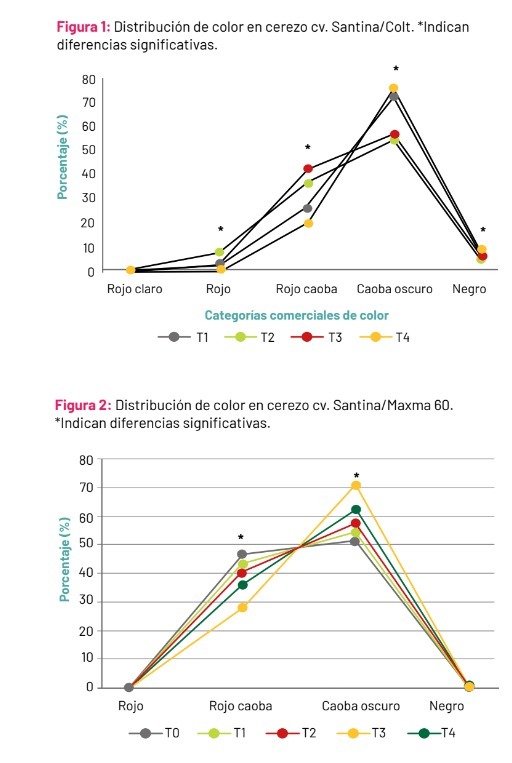
It should be noted that in all evaluations carried out, fruit firmness was not affected.
Conclusions on the experiments
Considering the conditions of this first season, it is possible to conclude that two applications of GA3 at a concentration of 15 ppm, one at color change and 7 days later (T4), seem to be the ideal strategy to obtain a larger size without delaying color development.
Furthermore, based on the results, this could be part of a management strategy when planning the harvest, as having blocks with different color development allows for staggered harvesting, thereby improving the logistics of the process, increasing machinery and labor efficiency.
Considering the results of the first season of evaluation, an experiment was conducted during the 2023-2024 season in a Santina orchard on Colt rootstock planted in 2013. On this occasion, a control treatment (no application) was considered, and two application times (bright green and color change) and two doses of gibberellic acid (15 and 20 ppm) were evaluated. Details are described in Table 3.
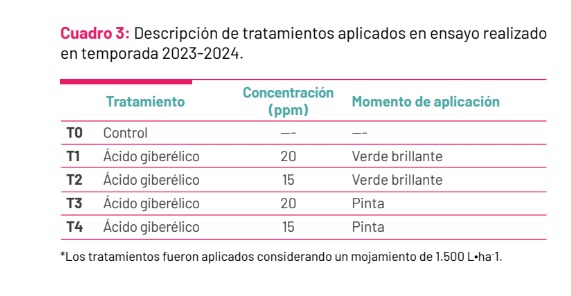
The results showed an effect from the application of a high dose of GA3 applied early (T1) and from the low dose applied late (T4), with an average increase of 0.5 mm in size and 11.7% more fruit concentrated in the category above 30 mm compared to the other treatments (Table 4).
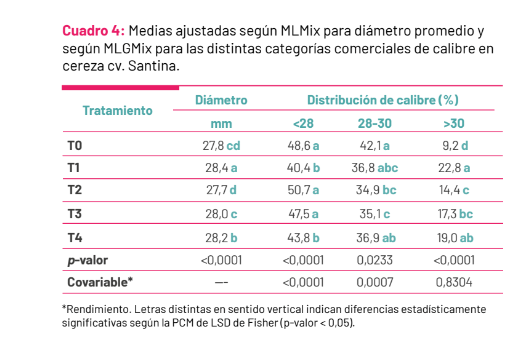
Final considerations on fruit color
Regarding fruit color at harvest, the best-performing treatments were late applications (color change) of GA3 (T3 and T4), which showed greater concentration of harvest in the dark mahogany category, advancing color development compared to the control treatment.
The early application (bright green) of GA3, regardless of dose used (T1 and T2), showed no differences in color compared to the control treatment (Figure 2).
Considering the conditions of this experiment, it is possible to conclude that late applications of GA3, regardless of dose used, do not delay color; additionally, the use of a low dose of GA3 applied late (color change) increases average size and the concentration of fruit in the category above 28 mm, being the best alternative for early varieties targeting early market entry.
However, understanding that due to various limitations, harvests need to be carried out in a staggered manner, the early application of a high dose of GA3 can be a good alternative to increase fruit size without affecting color development.
Finally, although there are several strategies to promote size increase, it is essential to apply them at the right doses and times to achieve greater effect. In addition, it is important to remember that these applications are complementary to good management of the leaf-to-fruit ratio (proper early load regulation) and correct irrigation and fertilization.
Fernando Quezada M.
M. Sc. Ing. Agrónomo Investigador Centro I+D CER
Source: Mundoagro
Cherry Times - All rights reserved









